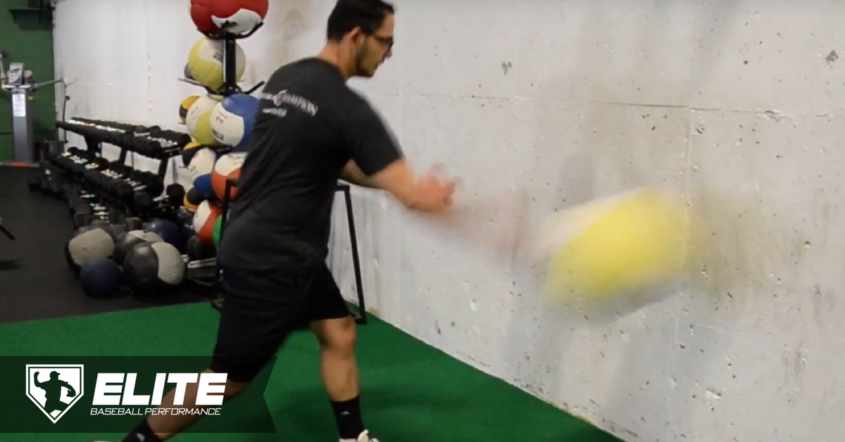3 Ways Baseball Players Can Become More Explosive
Baseball is a game of explosive movements, but is often trained like an endurance sport.
Too often, baseball players are running poles or some other type of long distance running. They need to train explosively to match the demands of their sport.
Though coaches prescribe distance running to help get players in shape, getting in shape for baseball is different than getting ready to run a 5K race. In baseball, you need to be able to perform an explosive movement and then repeat.
Your body adapts to what you constantly do. If you are consistently training slow, then when it is time to perform, you will perform slow.
The right training program is more important now than ever because throwing velocity, power-hitting, and speed on the basepaths are more valuable than they have ever been. To be able to keep up with increasing performance standards, players must train to be explosive. And to improve explosiveness, players have to train explosively.
Three Exercises That Improve Explosiveness in Baseball Players
Sprinting, jumping and throwing medicine balls are exercises that should be emphasized to help players increase power and explosiveness.
No training method will perfectly replicate an actual baseball game, but training should mimic what a player is required do over and over. Instead of running poles for 20 minutes or running suicides, a player should run sprints, throw medicine balls, and jump.
Sprinting
Players don’t need to be elite sprinters and spend all their time working on sprinting, but it should definitely be part of their training plan.
Sprinting is the most explosive movement a person can do, yet many baseball players don’t train it, despite the obvious fact that most running on the diamond comes in short bursts. Sprinting doesn’t get enough love in training.
Yes, sprinting will better prepare a player for the game, but it will also help him get faster and become more explosive. Both are great results, especially in a sport in which speed and power are crucial for success. Therefore, it doesn’t matter if you’re trying to get faster or get yourself in “baseball shape,” sprinting should be an important part of your program.
How to Add Sprints To Your Workout
When programming sprints, there are numerous options. A few variations include hill sprints, sled sprints, and regular sprints on flat ground. When sprinting, it’s important to remember to not turn it into an endurance session. Players need to build up the amount of reps they perform, get enough rest in between sets, and make sure they are putting the same intensity into each sprint.
So, depending on where a player is in his training cycle, 6-12 sprints per session is a good number of reps. When performing these reps, anywhere from 10-60 yards are good distances to use.
When it comes to rest, 1-3 minutes in between each sprint is a good amount. The shorter the distance, the lower the rest.
Medicine Ball Throws
Baseball is a rotational sport and is also very repetitive, so being able to produce power while rotating is crucially important. Both hitting and throwing are rotational movements, so being good at rotating powerfully applies equally to all positions. Being able to rotate and put force behind it is what will allow ballplayers to continually throw harder and hit for more power.
Like any skill, in order to get better at rotating and repeat it over and over, a player has to work on it.
Nothing will replace throwing and hitting, but incorporating rotational medicine ball throws into a player’s training is a great way to work on rotation, get stronger in the transverse plane (the plane in which we are twisting at the hips), and learn to put more force into the ground.
When throwing medicine balls, it is important that they are performed with a high intensity. Each throw should be explosive and work on developing power. Doing this will help a player produce more total power, but also help improve his ability to give maximal effort repeatedly.
Two of my favorite medicine ball throws are the Standing Scoop Toss and the Rotational Scoop Toss:
Just like with sprinting, it’s important not to turn it into an endless session of throws. Too many throws in a session will reduce the ability to put maximum force behind the ball, which is what is required to become more explosive over time.
To avoid an endurance session, 2-5 sets of 2-6 reps per side is a good number of reps and you should still be able to put enough force behind the ball to get outcome you’re looking for.
The goal is force and velocity, so be smart about the weight of the ball. When in doubt, stay on the lighter side – 2 to 6lbs.
Jumping
Finally, jumping must be part of a player’s preparation if he wants to be well-rounded. Developing power through jumping will improve force production and have great carry over on the field.
When it comes to jumping for baseball, the plane of motion matters. Sagittal plane jumping -such as vertical jumps – will help develop power, but won’t have as much carry over as lateral-based jumping or frontal plane jumping. The skater jump is a great example of a lateral jump, and the broad jump is a common frontal plane jump variation.
These examples – as well as single leg jumping variations – will better prepare the athlete for the demands of the game and have more carry over to baseball compared to vertical jumps.
Two common jumping drills that I perform are the Band Resisted Broad Jump and the Lateral Skater Hop:
When programming a workout it is important to have a plan. Endless amounts of jumps will turn into conditioning and won’t produce the desired result.
Jumping should be done in the 1-5 rep range, with the focus being to keep the effort and production close to the same. When jumps start to get outside this rep range, the ability to produce the same amount of force goes down.
Just like the throws, 2-5 sets of 2-5 reps per side is a good number of reps. The more intense the jumping variation, the lower the total amount of jumps you should perform.
The goal with each jump is distance or height, so always focus on each rep being as close to the same as possible.
Improve Your Performance on the Diamond
No longer should baseball be looked at as a game that you need to get ready by running poles or other forms of long distance running.
Remember: your body adapts to what you repeatedly do. Because baseball is an explosive sport, force your body to adapt to explosive movements. Sprinting, medicine ball work and jumping are all explosive movements that will properly prepare your body for the demands of the game. Consistently program them into your baseball training routine, and you’ll soon be performing at a higher level.
Matt Rossignol
Latest posts by Matt Rossignol (see all)
- 3 Ways Baseball Players Can Become More Explosive - June 5, 2018
- 3 Single Leg Exercises to Build Strength and Improve Force Production for Baseball Players - February 27, 2018










Hi Matt, Appreciating the time and effort you put into your website and in depth information you offer. You’ve really covered up almost all the possible info that every baseball enthusiast should follow. Worth sharing! Please continue sharing your updates! Thanks a lot!
Great insights! I never thought about how powerlifting could translate to more explosiveness in baseball. I’m definitely going to incorporate more plyometrics into my training routine. Thanks for sharing!
Great tips! I found the emphasis on plyometrics particularly interesting. I think incorporating those exercises into our training could really enhance our power and explosiveness on the field. Thanks for sharing this valuable insight!
Great tips in this post! I love how you break down the importance of strength training and specific drills for increasing explosiveness. I’m definitely going to incorporate some of these exercises into my routine. Thanks for sharing!
Great tips! Focusing on strength and explosiveness is crucial for performance. I especially found the plyometric exercises section helpful—can’t wait to implement these into my training routine. Thanks for sharing!
Glad you enjoyed it!
Great insights! I never considered how flexibility plays such a crucial role in explosiveness. I’ll definitely incorporate some of these training tips into my practice routine. Thanks for sharing!
Great insights! I never thought about how plyometrics could directly improve my swing power. I’m definitely going to try incorporating some of these drills into my training routine. Thanks for sharing!
Lost Life APKis a story of a schoolgirl that offers a horror and emotionally engaging experience for players. Lost Life APP is an interactive simulation that has garnered attention for its emotional depth, decision-driven gameplay, and immersive storyline. This app provides an opportunity for players to delve into the daily routine faced by students, allowing them to navigate various aspects of school life.
Lost Life APK is a story of a schoolgirl that offers a horror and emotionally engaging experience for players. Lost Life APP is an interactive simulation that has garnered attention for its emotional depth, decision-driven gameplay, and immersive storyline. This app provides an opportunity for players to delve into the daily routine faced by students, allowing them to navigate various aspects of school life.
Honista allows users to view stories and posts without notifying other users. Users can hide their online status, using the app without appearing online. It also enables reading messages without marking them as seen, offering more flexibility with message interactions.
It can be difficult to find free, high-quality, culturally relevant entertainment in the era of digital streaming. Introducing Canela TV , a new streaming phenomenon with a massive library of movies, TV shows, and original programming produced specifically for Latinx audiences.
Great insights! I love the focus on explosiveness in baseball. The tips provided on strength training and flexibility are super practical. Can’t wait to implement some of these exercises into my routine!
Great insights! I really appreciate the focus on strength and agility drills. It’s fascinating how small changes in training can lead to major improvements in performance. Can’t wait to try out some of these explosiveness tips in my workouts!
Cinegato APK offers live TV streaming and provides users with direct access to popular live TV networks, including entertainment, sports, and news. It’s a great alternative to cable TV services, allowing users to watch live events, competitions, and special broadcasts without a cable subscription.
Great insights in this post! I love the focus on improving explosiveness for better performance on the field. The specific exercises mentioned are practical and easy to incorporate into my training routine. Can’t wait to try them out and see the results!